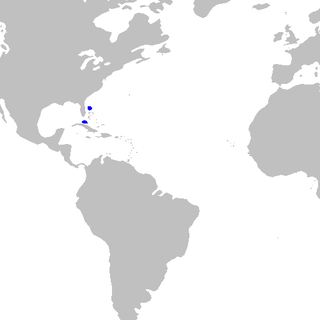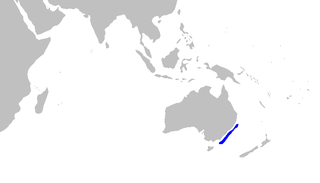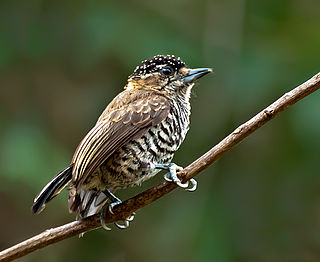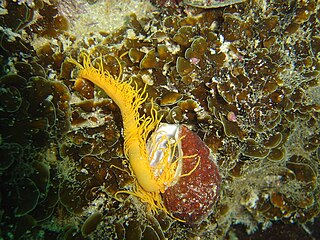
A sawshark or saw shark is a member of a shark order bearing a unique long, saw-like rostrum edged with sharp teeth, which they use to slash and disable their prey. There are eight species within the Pristiophoriformes, including the longnose or common sawshark, shortnose sawshark, Japanese sawshark, Bahamas sawshark, sixgill sawshark, African dwarf sawshark, Lana's sawshark and the tropical sawshark.

The Bahamas sawshark, Pristiophorus schroederi, is a sawshark of the family Pristiophoridae, found in the western Central Atlantic Ocean from the Bahamas and Cuba at depths of between 400 and 1,000 m. These sharks are at least 80 cm long.

The longnose sawshark or common sawshark, is a sawshark of the family Pristiophoridae.

The Eastern Australian sawshark, Pristiophorus peroniensis, is a sawshark of the family Pristiophoridae, found off southeastern mainland Australia at depths of between 100 and 630 m. Its length is up to 1.36 m.

The Chthamalidae are a family of chthamaloid barnacles, living entirely in intertidal/subtidal habitats, characterized by a primary shell wall of eight, six, or four plates, lacking imbricating plate whorls, and either membraneous or more rarely calcareous basis. They are not found below immediate subtidal habitats, and more likely are found in the highest tier of shallow-water barnacle fauna. They can be found in the most rigorous wave-washed locations, and some species are found in the surf zone above high tide mark, only receiving water from wave action at high tide.
A blind fish is a fish without functional eyes. Most blind fish species are found in dark habitats such as the deep ocean, deep river channels and underground.

The white-barred piculet is a species of bird in the family Picidae, the woodpeckers, piculets, and wrynecks. It is found in south-eastern Brazil south and west to the Pantanal, and into south-eastern Bolivia, Paraguay and northern Argentina. A disjunct population occurs in the coastal parts of French Guiana, south to the Brazilian state of Amapá and west along the lower Amazon River up to around the Tapajós River. A small, apparently isolated population is found in southern Guyana and adjacent Roraima. Its natural habitats are subtropical or tropical dry forests, subtropical or tropical moist lowland forests, and heavily degraded former forest.

The ochraceous piculet is a species of bird in the family Picidae. It is endemic to eastern Brazil.
Taenioides cirratus is a species of worm goby native to the Indian Ocean and the western Pacific Ocean from islands offshore of eastern Africa to New Caledonia and from Japan to Australia. This species can be found in estuaries and coastal waters, preferring areas with mud substrates feeding on small crustaceans and other invertebrates. It is capable of surviving in air for a considerable period by sucking air into its bronchial chambers. This species can reach a total length of 30 cm (12 in).

Terebellida make up an order of the Polychaeta class, commonly referred to as "bristle worms". Together with the Sabellida, the Spionida and some enigmatic families of unclear taxonomic relationship, they make up the subclass Canalipalpata, one of the three main clades of polychaetes. Like most polychaetes, almost all members of the Terebellida are marine organisms. Most are small, sessile detritivores which live in small tubes they build from mud or similar substrate, or burrow in the sand. Their central nervous system displays characteristic apomorphies.

Pristiophorus is a genus of sawsharks found in the Pacific, Atlantic and Indian oceans. Members of this genus differ from the Sixgill Sawshark (Pliotrema warreni) in having five gill slits. Their rostral sawteeth lack prominent transverse ridges on the basal ledges, and the large teeth are not posteriorly serrated.

Cirratulus cirratus is a species of marine polycheate worm in the family Cirratulidae. It occurs in the littoral and sub-littoral zones of the Atlantic Ocean.

Notochthamalus scabrosus, the only species in the genus Notochthamalus, is a species of barnacle found along the south-western and south-eastern coasts of South America, from Peru to the Falkland Islands. The species is found almost exclusively higher in the intertidal zone than the mussel Perumytilus, often codistributed with the confamilial barnacle Jehlius cirratus and Balanus flosculus.
Astroblepus cirratus is a species of catfish of the family Astroblepidae. It can be found on South America.
Streptomyces cirratus is a bacterium species from the genus of Streptomyces. Streptomyces cirratus produces phegomycin, phegomycin D, phegomycin DGPT, cirratiomycin A, cirramycin A and cirramycin B.'
Malacoscylus cirratus is a species of beetle in the family Cerambycidae. It was described by Ernst Friedrich Germar in 1824. It is known from Argentina, Brazil and Paraguay.
Halitholus is a genus of cnidarians belonging to the family Pandeidae.

Jehlius is a genus of star barnacles in the family Chthamalidae. There are at least two described species in Jehlius.
Oregodasys is a genus of worms belonging to the family Thaumastodermatidae.











